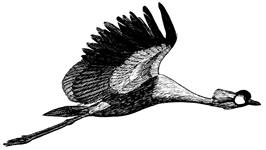Papers in the Biological Sciences

Cranes of the World by Paul A. Johnsgard
Date of this Version
January 1983
Document Type
Book Chapter
Abstract
Like all higher organisms, cranes perform a variety of behavior patterns throughout their lives that have evolved to fulfill diverse functions. Much of their time is spent in self-directed activities necessary to maintain life and health. These individualistic or "egocentric" activities include such fundamental behaviors as breathing, eating, defecation, drinking, and sleeping or resting. Other activities, while not vital to life, are usually performed during "leisure time"; these include preening, shaking, stretching, oiling, and other actions that fall within a general umbrella of "comfort" activities. Still other activities, such as foraging and the seeking of shelter, result in aggregations of cranes drawn to the same environmental conditions, and such "quasi-social" behaviors may lead to actual social interactions. These truly social behaviors require the presence of another individual for their performance, with one individual serving as a "sender" of specific social signal's (aggression, appeasement, sexual attractions, solicitation of food, etc.), while one or more other individuals serve as "receivers" of such signals. Frequently the "receiver" also becomes a "sender," and the simultaneous or sequential exchange of signals between individuals often results in complex social interactions that provide the basis for integration of pairs, families, and flocks. The following summary of egocentric and social behavior patterns in cranes is primarily based on Voss's (1976) inventory of behavior patterns in the greater sandhill crane; with little variation most or all of these patterns can be regarded as characteristic of cranes in general.


Comments
From Cranes of the World by Paul A. Johnsgard (Bloomington, IN: Indiana University Press, 1983; electronic edition: Lincoln, NE, 2008). Copyright © 1983 Paul A. Johnsgard.